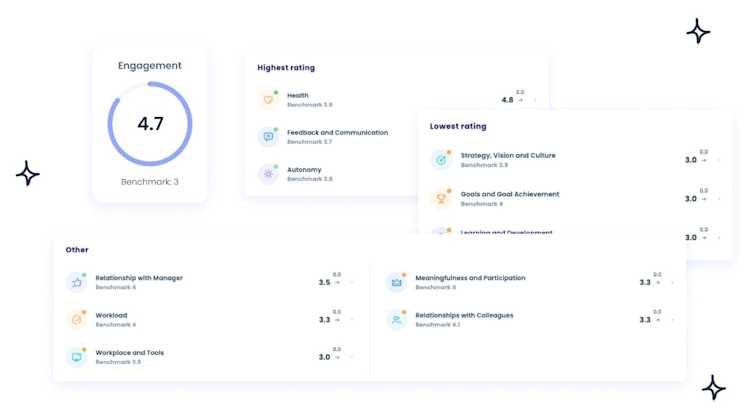Engaged employees build successful organizations. But how do you know how employees feel and perceive their employee experience and work environment? Employee wellness surveys, also called employee engagement surveys, will give you that answer.
Get the Answers You Need to Improve Employee Wellness
There are different ways to measure employee wellness, and the surveys used for this are called many different things. Employee wellbeing surveys, health and wellness surveys, staff surveys, employee satisfaction surveys, employee happiness surveys, and employee engagement surveys are all terms used to describe surveys made to measure employee engagement.
The purpose is to collect employee feedback in order to understand how the organization can best build a workplace where people thrive and perform at their best.
Employee survey examples
Let's have a look at some different types of employee surveys, and the different use cases for them.
Employee pulse surveys
Employee pulse surveys, or staff pulse surveys, are short and quick digital surveys sent out on a regular basis. The surveys can be sent out weekly, bi-weekly, monthly, quarterly, or yearly. These surveys provide a pulse check on how your organization is doing, and how your employees are feeling. The questions in the pulse surveys should include all the important drivers of employee engagement and cover all areas needed to understand the employee experience. This includes a number of different variables, from day-to-day work-life balance and mental health to relationships with team members and managers.

We've written more extensively about the drivers of employee engagement here: The best employee engagement survey questions – what to ask and why
Annual employee surveys
The old-school way to measure employee engagement and employee well-being is by sending out one big yearly survey containing a large number of questions. This is a way of working that most companies are moving away from, in order to work in a more agile way. It's important to remember that yearly surveys only provide a snapshot of that moment in time, but things like employee engagement and employee wellness fluctuate with time.
Recommended reading: Realtime pulse surveys vs. annual employee engagement surveys
Custom surveys
Sometimes, you may want to create specific surveys related to specific topics. These surveys may not need to be repeated or to be sent to the whole organization. Then a custom survey created for that particular use case is a great option. Custom surveys can be used for big and small things, and they can be extensive or only include one single question.
Onboarding surveys
Onboarding surveys, or new hire surveys, are valuable when you want to measure the onboarding experience for new employees. By collecting anonymous feedback, you can identify where there is room for improvement and adjust and develop the onboarding process accordingly. By continuously monitoring the onboarding experience and the employee experience through the whole employee lifecycle, you can also see if the actions you take are leading to improved survey results.
Exit surveys
Exit surveys are extremely valuable and a great way to collect insights about how you can improve the employee experience and company culture. People who are about to leave your company have first-hand knowledge about what is working well in your organization, and they're also the ones who know best why they're leaving. Asking them for feedback in a structured way, and taking action on that feedback, is a powerful way to increase retention and reduce employee turnover.
Diversity and inclusion surveys
When working with various DE&I initiatives, it's crucial to be able to monitor the results and track progress. Since diversity and inclusion have both objective and subjective aspects, it's essential to have a way to track the internal perception of these matters. A diversity and inclusion strategy needs to include a reliable method for measuring the outcome, and employee surveys are a great tool for this.
Read more about measuring the impact of your DE&I initiatives here.
Agile HR requires real-time insights
Over the past decade or so, a significant shift has taken place in how companies work with employee engagement. From no surveys to yearly surveys, via pulse surveys, to intelligent employee engagement surveys based on adaptive algorithms and machine learning.
Having tools in place to gather employee feedback has gone from nice-to-have to a must-have, and in many countries, a formal channel for feedback and whistleblowing is now required by law. A lot has also happened on the technical side of employee engagement surveys.
We've written extensively about the trends in this field in this article: How intelligent employee surveys can improve your people decisions
Employee wellness surveys: Best practices
So, what are the best practices for measuring employee wellness? We've listed a few pointers below.
Use real-time pulse surveys to measure employee engagement
Decide on follow-up routines and stick to them
Use open-ended questions in your surveys
Set the expectations and communicate them to everyone
Empower self-leadership and create a culture of accountability
Ensure there's a feedback loop in place from the start
Integrate your surveys with your tech stack to increase employee survey participation
Complement employee engagement surveys with performance management programs
For more in-depth reading on the topic of best practices for employee wellness surveys, we recommend this article: Best practices for employee engagement surveys
FAQ
What are employee wellness surveys? Employee wellness surveys, also called employee engagement surveys, are surveys used to measure employee engagement and how employees feel and perceive their employee experience and work environment.
What are the different types of employee surveys? Employee pulse surveys, employee wellbeing surveys, health and wellness surveys, staff surveys, employee satisfaction surveys, employee happiness surveys, and employee engagement surveys are all types of surveys used to measure employee engagement.
What is the purpose of employee surveys? The purpose of employee surveys is to collect employee feedback in order to understand how the organization can best build a workplace where people thrive and perform at their best.
What are the best practices for employee wellness surveys? Best practices for employee wellness surveys include using real-time pulse surveys to measure employee engagement, deciding on follow-up routines and sticking to them, using open-ended questions in surveys, setting expectations and communicating them to everyone, empowering self-leadership and creating a culture of accountability, ensuring there's a feedback loop in place from the start, integrating surveys with tech stack to increase employee survey participation, and complementing employee engagement surveys with performance management programs.
What are onboarding surveys? Onboarding surveys, or new hire surveys, are surveys used to measure the onboarding experience for new employees. They are used to collect anonymous feedback in order to identify where there is room for improvement and adjust and develop the onboarding process accordingly.

























